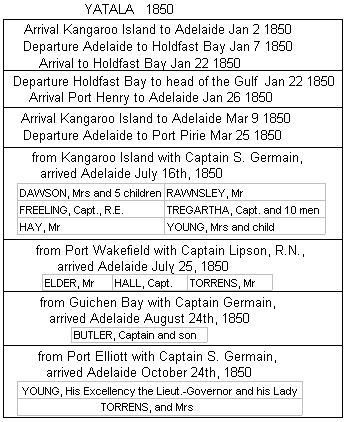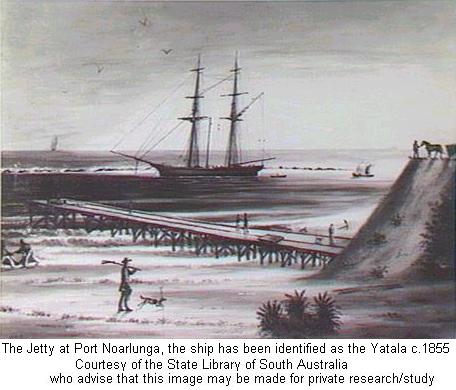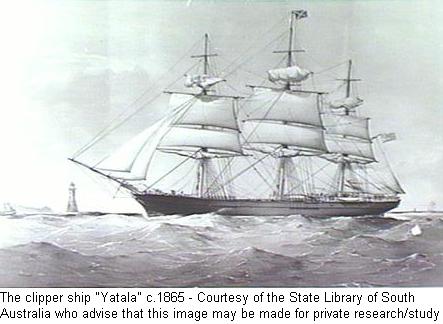|
 |
TO READ HOW
'YATALA' ASSISTED at the
WRECK OF THE SHIP “MARION” ON TROUBRIDGE SHOAL
Click this list (below)

|
Yatala 1855 - SLSA Mortlock Pictorial Collection

In 1858 Captain Bloomfield Douglas made a detailed survey of the West Coast in the schooner YATALA.
Yatala 1865 - SLSA Mortlock Pictorial Collection

Friendly rivalry between the CITY OF ADELAIDE (Capt Bruce) and the YATALA (Capt Legoe) resulted in an ocean race which began a day or so after Christmas, in 1866, from Adelaide to England. The YATALA cast off from Port Adelaide a few hours before the CITY OF ADELAIDE, and got into Table Bay a few hours before. Two or three days later the YATALA resumed the voyage, once more a few hours before her rival, and passed Land’s End the day before. The YATALA had double tops’le yards, and that was a distinguishing feature on the voyage, during which she was occasionally sighted by those on the CITY OF ADELAIDE. All on board used to fraternize cordially during the long period at sea, and that was how Capt Bruce became acquainted with so many families in South Australia.
SOUTH AUSTRALIAN REGISTER, June 11, 1867
The Ocean Race – The interest which has been excited by the race home between the two celebrated clippers, YATALA and CITY OF ADELAIDE, will be increased by the extracts from letter which we publish below. It is clear that they are about a match in speed.
A lady passenger on board the ship YATALA on her last voyage writes:-
"We arrived on the 8th April, and were in the Docks at about 5 o’clock. Captain Legoe is deservedly popular; he is such a nice person, so kind, attentive, and obliging; the perfection of a captain and a seaman, always at his post and attending to his duty. The ship is beautifully clean, kept in order, and well found. When we went into the Cape it was in the teeth of a strong south-easter, and of course we had to tack. We afterwards heard on the shore that numbers of people were watching the vessel, and the exclamation was – ‘That ship has a first-rate seaman on board’. We went in with one tack, which they say is a most unusual thing, and that the vessel looked beautiful, she was so well handled…. You will have heard that we beat the CITY OF ADELAIDE. Several times when we were becalmed or had light winds we saw her quite near; it was very close; but in the end we were in the Docks 48 hours before her; but the precise time I am not sure of; it was at least a day. We passed quite close to St Helena on a lovely day; we could almost distinguish the people in the streets.”
The following is an extract from a private letter from Captain Legoe, dated London, 25th April:-
“I arrived in London on the 8th instant, and Bruce (CITY OF ADELAIDE) passed through the Downs on the following morning, but did not get in dock for two days, owning to the heavy weather from the westward. We had a close run for it. I was through the Downs on Sunday, and Bruce on Tuesday following. I saw him at sea 12 days before I arrived, and as the breeze freshened I went away from him.”
To these we add the following extracts from a letter written to a gentleman in Adelaide by Captain John Bruce, then chief officer on the CITY OF ADELAIDE. His friends will be glad to see that he is promoted to the command of the vessel which his father has made so popular:-
“London Dock, April 26th – No doubt this trial of prowess between the two vessels is of subordinate importance to you; but the ocean race possesses on this occasion features that should not be passed over without being noticed. The register tonnage of the ‘CITY’ is 791; of the ‘YATALA’ 1,217. I don’t know whether in Adelaide this fact is known. At the Cape, in a newspaper paragraph, they were said to be an unfair match in class, age and size. The YATALA, if you remember, took the initiative in starting from the Lightship on account of our having to wait for some papers that were forgotten.
She got under weigh at 6 o’clock, while we had a ‘five hours’ cruise in the Gulf until we got the missing documents at 11am. At daylight on the following morning we found ourselves within a short distance of our competitor, and the evening saw us abreast of each other, with a fresh south wind, and not more tan a quarter of a mile apart. The custodians of the Cape Borda Lighthouse must have taken notice of us as they would have an uninterrupted view of the course for many miles.
During the night we did not steer parallel courses, for the next day the ‘YATALA’ was nearly hull down in a S.W. direction. Fog came on and lasted three days – rather unusual on the Australian coast I should imagine. The wind, E., was of course very light, as is the case with fogs. Light and variable winds characterized the passage to Cape Lewin, which we rounded on 7th January. On the 12th a large vessel was seen astern. Speculation was rife, and tendered to one conclusion – it was the ‘YATALA’. This probed so far on the 13th that the rig corresponded to the ‘YATALA’s. On the 14th all doubts were removed, as she was near enough to exchange signals. At noon on that day we were in Lat. 30o S., long. 100o E.
The ships parted company during the day, the wind a pleasant and increasing south east trade. Tedious weather succeeded in a few days, and we made slow progress to the Cape. On February 10, off Cape Afulhas (land in sight), the ‘YATALA’ was seen three miles ahead of us, gradually increasing the distance; the wind at the time was of the description that figures in sea logs as ‘faint, variable airs’. Three days afterwards (13th February) we anchored at Table Bay at 10pm. The ‘YATALA’ reached the same place at 6pm, four hours sooner. It blew hard from the south east during our stay, which terminated on the 16th, both ships leaving within half an hour of each other, ‘YATALA’ first. The ‘CITY’ crept up in the night, and the following evening she was six miles ahead. A head wind sprung up separating the ships. The ‘CITY’ made all speed through the trade winds S.E. and N.E.
To our amazement the ‘YATALA’ appeared right astern, in lat. 27o N., long. 40o W., on the 23rd March. It was calm at the time. The ‘YATALA’ brought a breeze with her, and both ships were again in competition. Heavy weather came on soon after, and on arriving in the Downs we got information from the tug steamer that the ‘YATALA’ had gone up the river the day before. The steamer that took her up came down to look for another job, and picked up our ship. We were detained 48 hours in consequence of the violence of the N.W. winds. Nothing happened to mar our comfort or enjoyment; fine weather nearly all the time. I am promoted to the command of the ‘CITY’. In the meantime my father will superintend the building of a new larger ship. The ‘YATALA passed the Downs 24 hours before our ship.”
|
|





